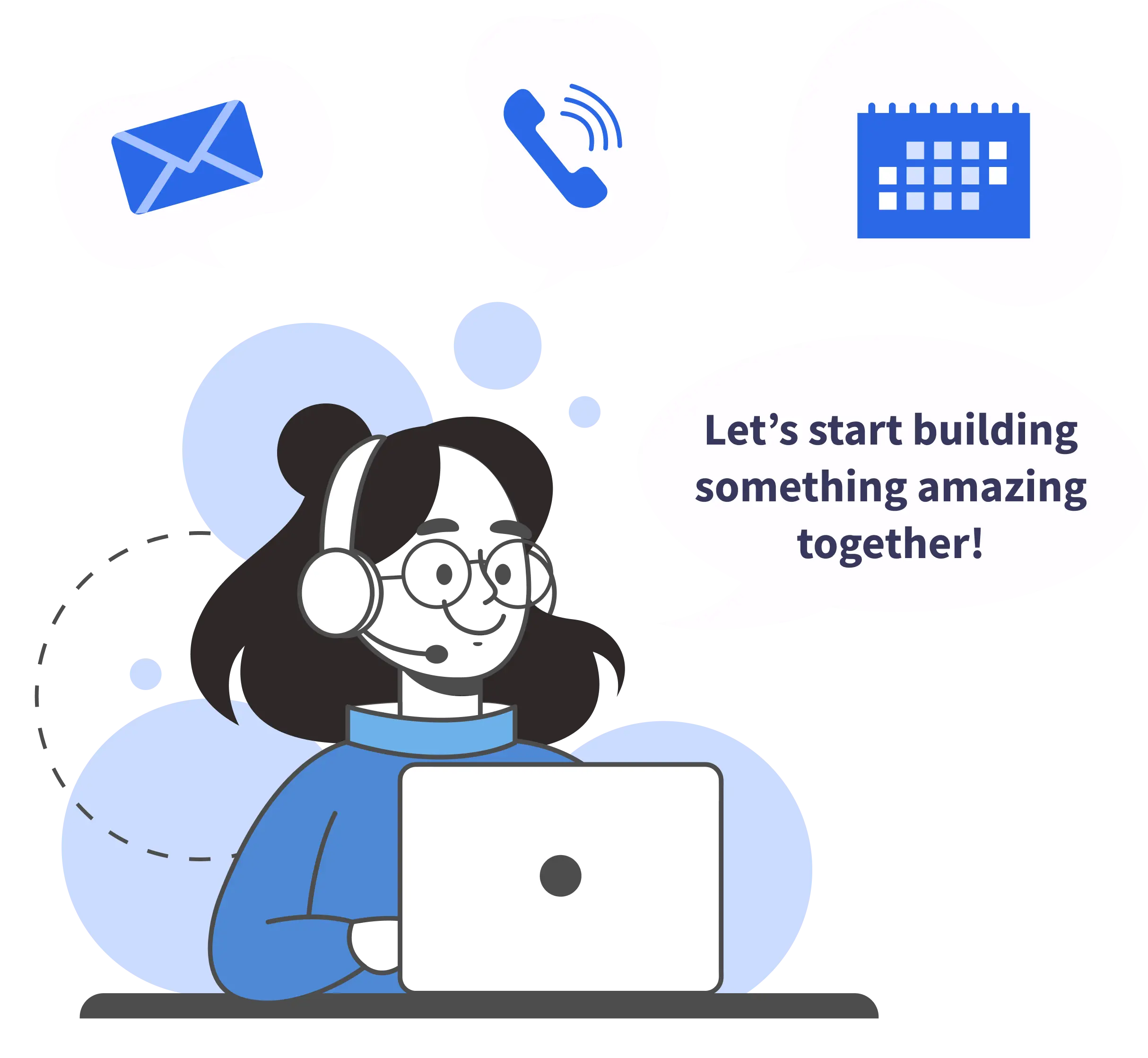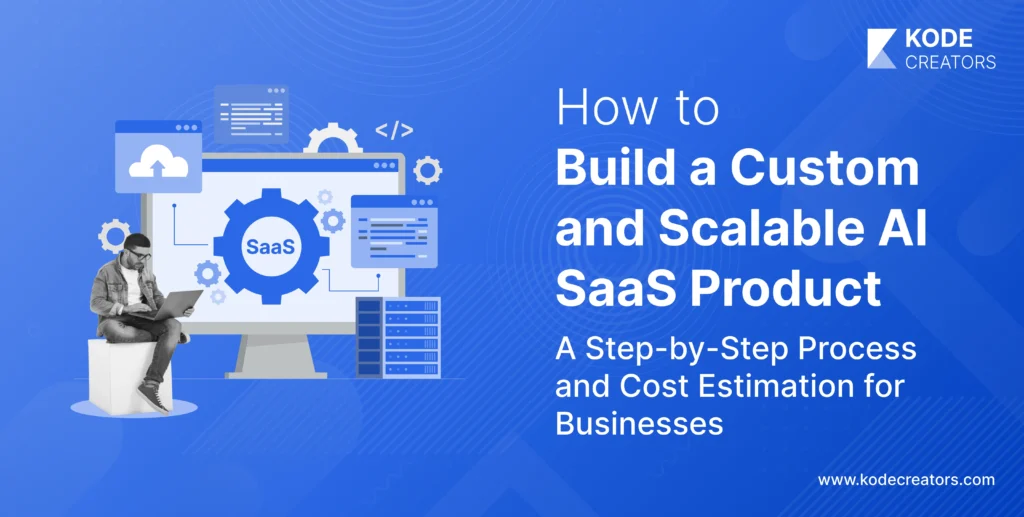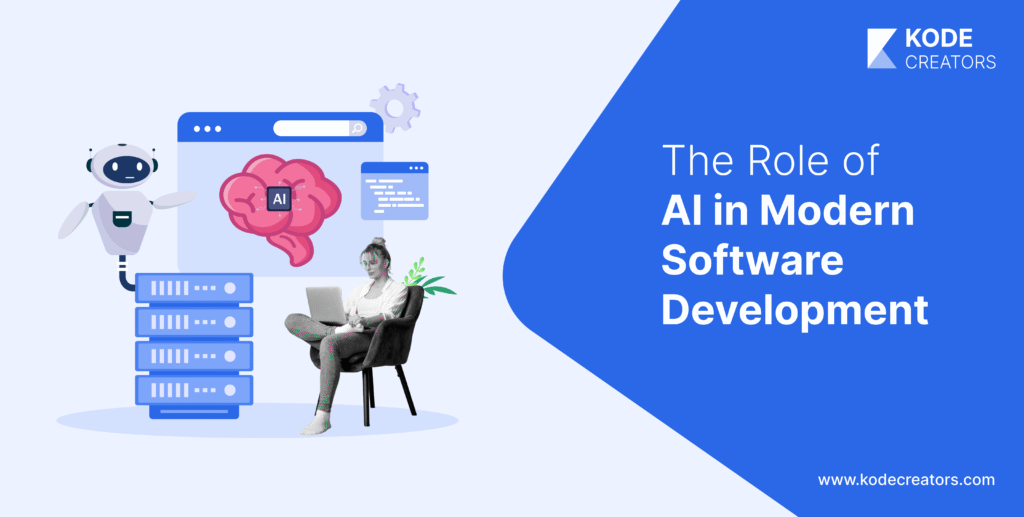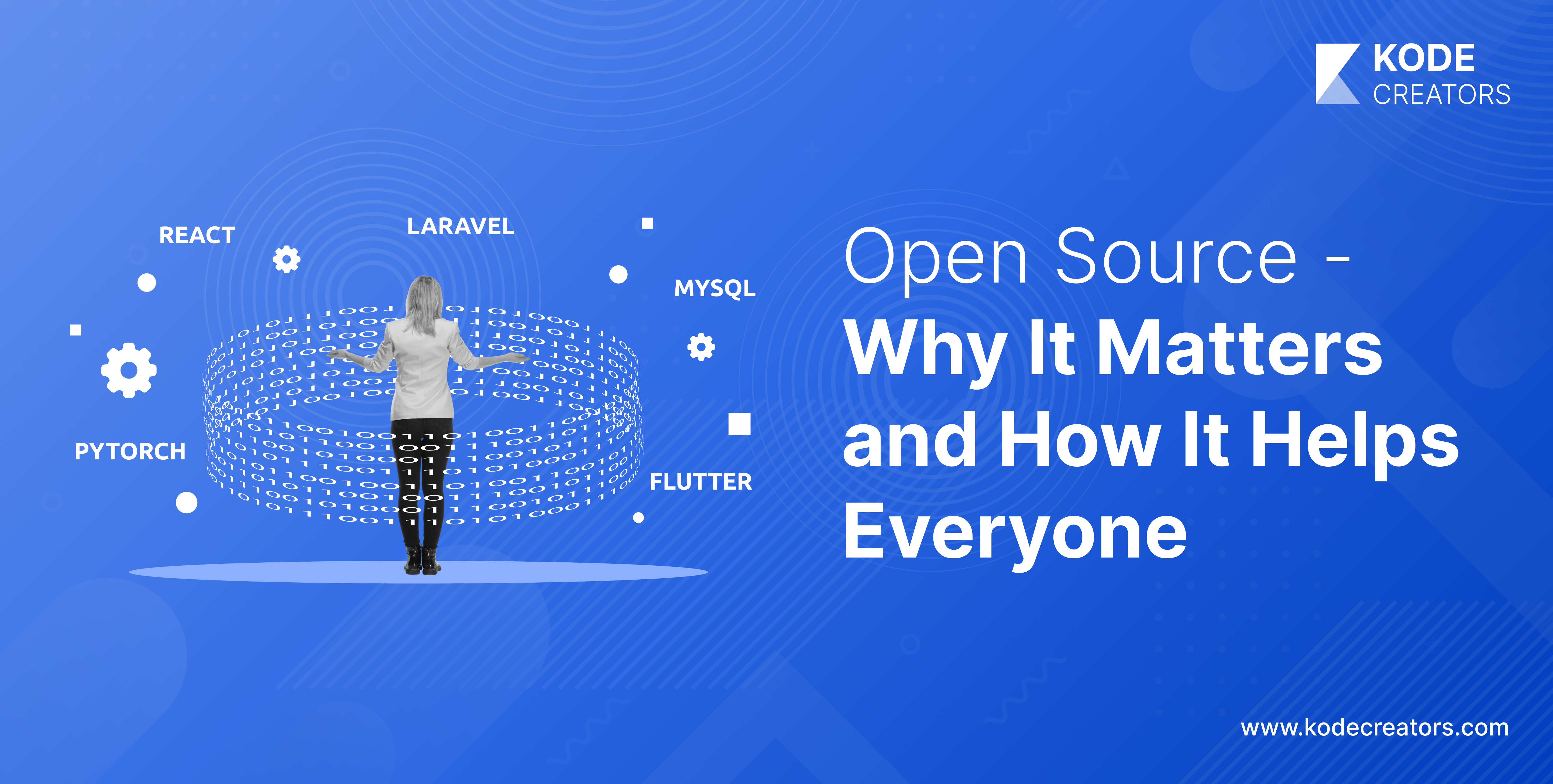AI influences the next wave of SaaS products turning old-school software into smart, flexible, and ever-changing tools. When you mix AI's strength with SaaS's adaptability, companies can tap into amazing chances to automate, personalize, and get useful insights. These days, customers expect a lot more. So, using AI isn't just about staying ahead—it's about keeping up with the competition.
AI-powered SaaS products have an impact on industries and make user experiences better. They automate tasks that repeat and give insights that help make smart choices. This guide shows you how to plan, build, and launch a great AI SaaS product. In essence, it will help you use new tech to solve real problems in the world. So let’s get started.
1. Understanding the Market Factors
Before you start developing an AI SaaS product, you need to understand the current market scene. A deep look at industry trends and what competitors offer helps you create a product that's both new and ready for the market.
Market Analysis: Current Trends and Growth
The AI SaaS market is booming. A report from Grand View Research predicts the global AI market size will grow at a compound annual growth rate (CAGR) of 37.3% from 2023 to 2030, with SaaS playing a big part. New technologies such as natural language processing (NLP), computer vision, and generative AI are leading to breakthroughs in automation, personalization, and predictive analytics.
The main trends include:
- Hyper-Personalization: AI SaaS tools now provide custom user experiences. They adjust on their own to match what each person likes and does.
- Automation at Scale: From chatbots helping customers to tools that crunch numbers companies use AI SaaS to make their work smoother and cut costs.
- Vertical-Specific Solutions: More and more businesses are choosing AI SaaS products made just for specific fields, like healthcare, money matters, and stores.
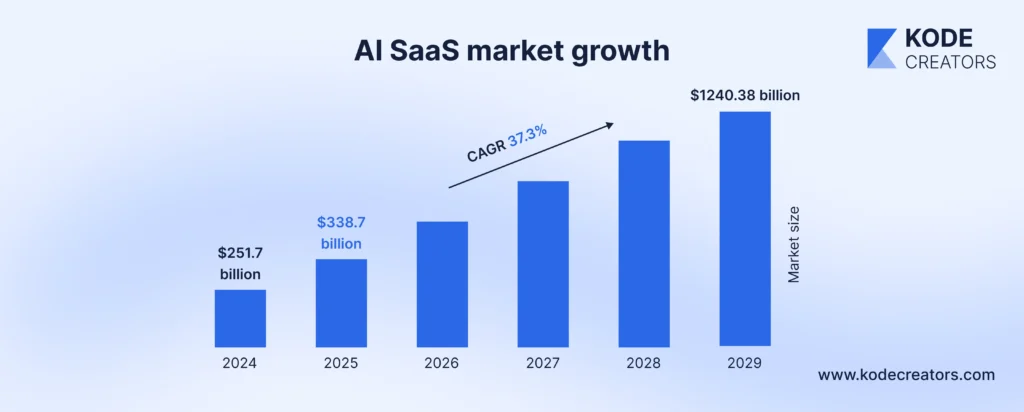
Competitor Analysis: Strengths and Gaps
We can learn a lot from looking at what other companies do because it shows us what people expect and where we can stand out. Top AI SaaS products often do well in:
- User Experience: Easy-to-use designs that fit right in with how people already work.
- Performance: Smart systems that give spot-on predictions and suggestions.
Still, there's room to get better in these areas:
- Customization: Many platforms find it hard to offer flexible solutions that meet the needs of different businesses.
- Affordability: AI SaaS products can cost too much for small to medium-sized enterprises (SMEs) creating a need for cheaper options.
Knowing these factors helps you create an AI SaaS product that fits with industry trends, fills existing gaps, and shines in a competitive market.
2. Planning and Ideation
A good AI SaaS product starts with a solid plan that tackles real business problems and offers a unique fix. Planning and coming up with ideas play a key role in making sure your product clicks with the target market and brings clear value.
Identifying Business Problems
The first step is to pinpoint specific challenges your AI SaaS product will tackle. Rather than creating a catch-all tool, concentrate on a niche problem that AI can solve well.
- Ask the Right Questions: What bottlenecks slow down operations? Which jobs could AI or smart data tools improve?
- Gather Insights: Talk to possible users, look at customer problems, and check out what's new in the industry. Let's say companies in your field find it hard to crunch numbers by hand. Your AI fix could make this job quick and easy.
- Quantify the Impact: Show how fixing this issue will boost productivity, cut costs, or bring in more money for your users. For instance, AI tools can cut down on manual work by 30% and help make choices 40% faster.
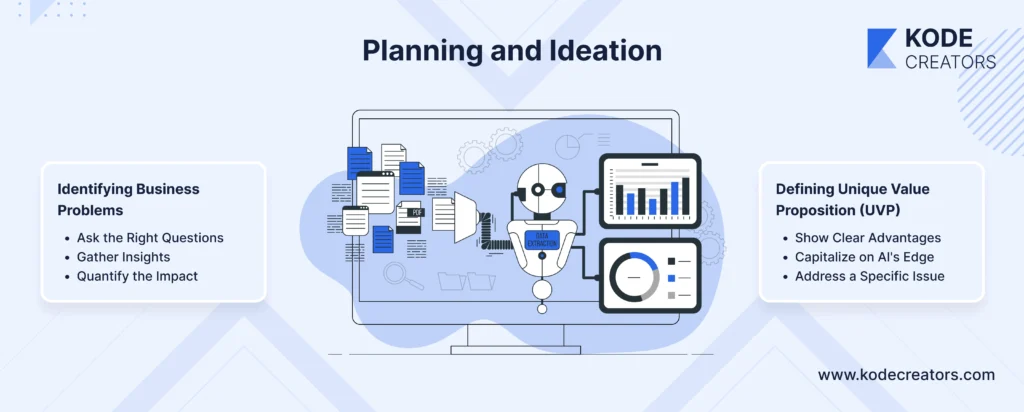
Defining Unique Value Proposition (UVP)
In the packed AI SaaS marketplace, a distinct UVP has a critical impact. Your UVP should provide an answer to this: Why would clients pick your offering instead of rivals?
- Show Clear Advantages: Zero in on what sets your product apart, like better precision simple operation, or cost-effectiveness.
- Capitalize on AI's Edge: Display features unavailable in regular SaaS products such as forecast analytics or on-the-spot customization.
- Address a Specific Issue: As an example, an AI SaaS tool made for retailers could offer ultra-tailored item suggestions based on shopper actions.
3. Carrying Out a Discovery Stage
The discovery phase plays a key role in creating a successful AI SaaS product. It helps shape the vision get stakeholders on the same page, and make sure the project is doable from both technical and financial standpoints. When teams skip this step, they often end up with mismatched goals and wasted resources, so it's vital to put time and effort into this stage.
Objective Setting
Clear objectives form the base of the project. Without them, development can lose its way and focus.
- Set SMART Goals: Create goals that are Specific, Measurable, Achievable, Relevant, and Time-bound. For instance, "Cut customer onboarding time by 25% within six months after launch."
- Align with Business Outcomes: Make sure the product's aims match wider business goals, like boosting user retention or increasing revenue.
- Prioritize Use Cases: Spot and concentrate on main use cases where AI can have the biggest effect.
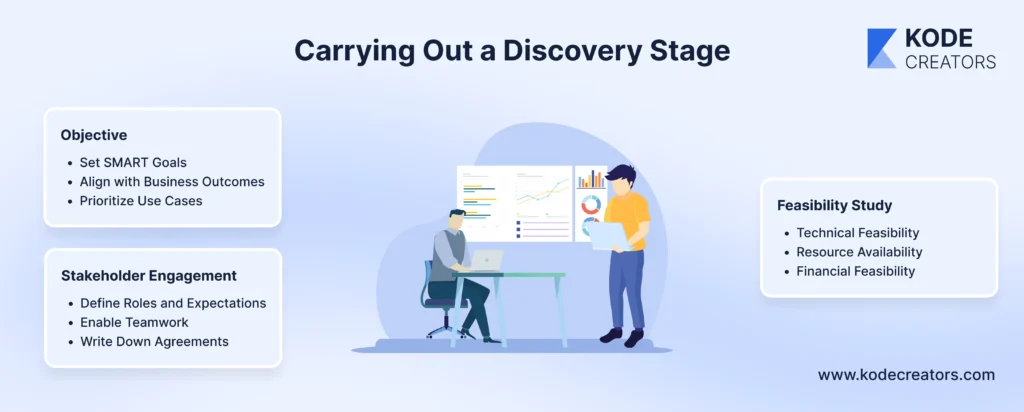
Stakeholder Engagement
Getting key stakeholders involved makes sure everyone understands the same thing and lowers the chance of poor communication later.
- Define Roles and Expectations: Get input from decision-makers technical leads, and end-users to gather different views.
- Enable Teamwork: Set up brainstorming meetings to shape the vision and tackle possible hurdles.
- Write Down Agreements: Spell out the goals and needs everyone agrees on to stop the project from growing too big.
Feasibility Study
Checking if the project can work is key to avoid expensive mistakes.
- Technical Feasibility: Check if the AI tools and tech you need are available and fit your aims.
- Resource Availability: Figure out the skills, setup, and data you'll need to build it.
- Financial Feasibility: Work out how much it'll cost to build, launch, and keep running. Use things like expected ROI to show it's worth the money.
4. Picking the Right Tech Stack
Choosing the right tech stack is key to building an AI SaaS product that's strong, can grow, and works well with other systems. The tech stack shapes how well the product performs how it can change, and how well it does in the long run.
AI Technologies
When you're building an AI SaaS product, it's crucial to pick the right tools and frameworks.
- Machine Learning Libraries: TensorFlow PyTorch, and Scikit-learn have wide usage to build AI models. Developers pick these frameworks because they're flexible and have strong community backing.
- Natural Language Processing (NLP): spaCy and Hugging Face tools work great to develop chatbots, analyze sentiment, and create other language-based answers.
- Computer Vision: OpenCV and Google Cloud Vision API help with image and video processing jobs.
- AI-as-a-Service Platforms: Google AI, AWS AI, and Microsoft Azure AI offer ready-made APIs. These APIs handle tasks like speech recognition and predictive analytics, which cuts down on development time.
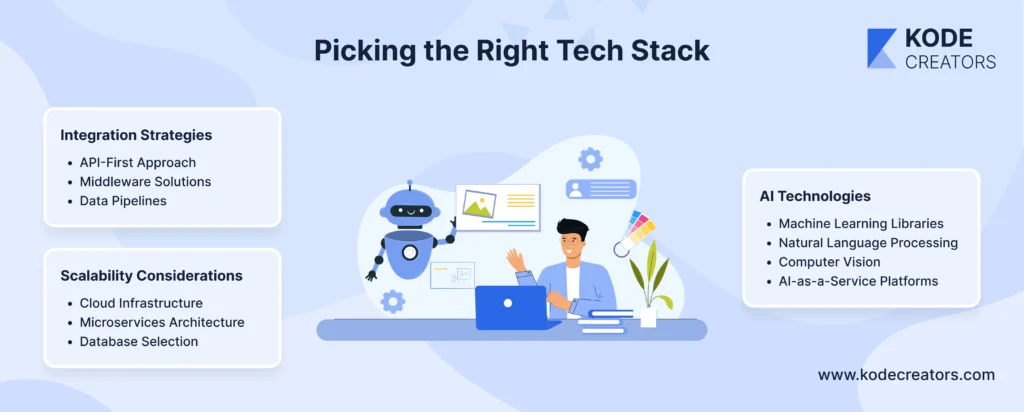
Scalability Considerations
To make sure your product can grow in the future, pick tech that can grow with it.
- Cloud Infrastructure: Services like AWS, Microsoft Azure, or Google Cloud give you space to host AI SaaS products that can expand.
- Microservices Architecture: Using microservices lets you grow different parts on their own making things work better and more .
- Database Selection: Pick databases like MongoDB or Amazon DynamoDB. They're built to handle lots of data and can spread out as you need more space.
Integration Strategies
When your product fits well with other systems more people will use it and it'll work better.
- API-First Approach: Create APIs that make it easy to connect with tools and services from other companies.
- Middleware Solutions: Use middleware to bridge gaps between your AI parts and other systems.
- Data Pipelines: Build strong pipelines to combine, handle, and control data flows well making sure the AI models get good quality inputs.
5. Putting Together the Development Team
To build a good AI SaaS product, you need a well-rounded development team with know-how in different areas. Each team member has an important job to make sure the product works well, is easy to use, and matches business goals.
Team Makeup
Having a balanced team is key to making an AI SaaS project work. Here are the main roles:
- AI Specialists:
- Role: Create and fine-tune AI models that make up the product's main features.
- Expertise: Skills in machine learning natural language processing, or computer vision based on what the product needs. Knowledge of tools like TensorFlow PyTorch, or OpenAI is a must.
- Software Developers:
- Role: Code the SaaS platform efficiently and add AI features.
- Expertise: Backend (Node.js Python) and frontend (React, Angular) tech, plus know-how with APIs and microservices setup.
- Data Scientists and Engineers:
- Role: Get datasets ready and manage them to train AI models making sure data is high-quality and consistent.
- Expertise: SQL, NoSQL databases, ETL pipelines, and big data tools like Apache Spark.
- UI/UX Designers:
- Role: Build easy-to-use interfaces and make user experiences better.
- Expertise: Wireframing, prototyping, and testing usability with tools like Figma or Adobe XD.
- Project Manager:
- Role: Keep an eye on project schedules how resources are used, and talk to stakeholders.
- Expertise: Agile methods handling risks, and working well with different teams.
- DevOps Engineers:
- Role: Put in place the setup for rollout and make sure it can grow and stay dependable.
7. Quality Assurance (QA) Testers:
- Role: Conduct rigorous testing to identify bugs and ensure the product meets quality standards.
- Expertise: Manual and automated testing tools, such as Selenium and Appium.
Collaborative Dynamics
Encourage cross-functional collaboration to leverage diverse expertise. Regular communication, clear role definitions, and shared project goals will help the team function cohesively and drive the AI SaaS product to success.
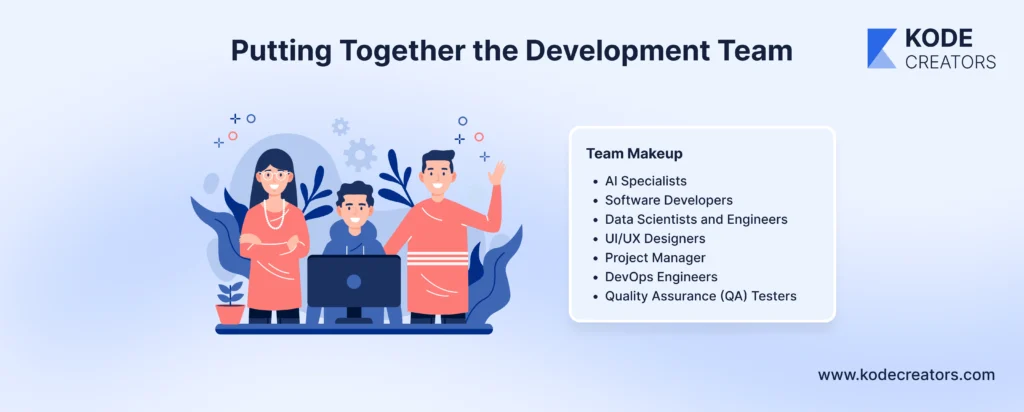
6. Development Process
A structured and user-focused development process is key to delivering a successful AI SaaS product. When you adopt flexible methodologies, validate ideas early, and prioritize the user experience, you can reduce risks and accelerate time-to-market.
Agile Methodology
Agile practices are ideal for developing AI SaaS products as they promote iterative progress and adaptability.
- Flexibility: Agile allows for frequent reassessments and modifications based on feedback or emerging requirements.
- Collaboration: Regular stand-ups and sprint reviews foster communication among team members and stakeholders.
- Incremental Progress: Delivering small, functional updates helps maintain momentum and ensures alignment with project goals.
When you break the project into manageable sprints, the development team can tackle challenges iteratively, making sure a higher-quality end product.
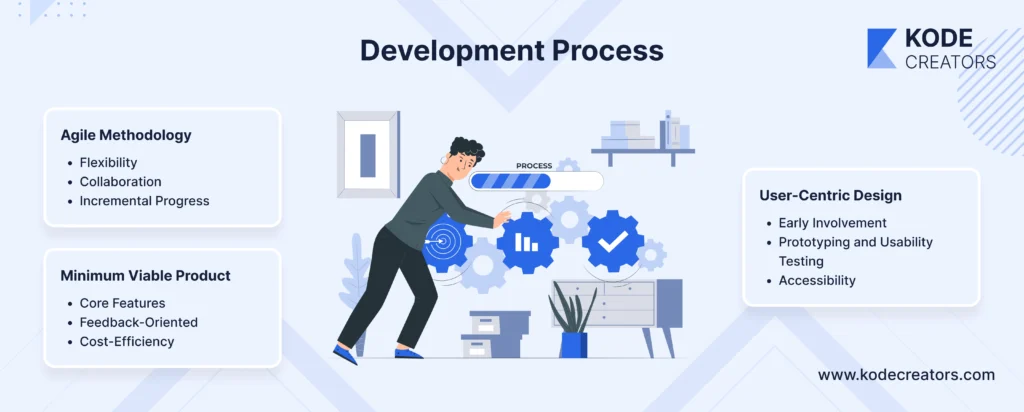
Minimum Viable Product (MVP)
An MVP is an essential step in validating your AI SaaS concept.
- Core Features: Focus on building only the most critical features that solve the primary user problem.
- Feedback-Oriented: Launching an MVP allows you to gather real-world feedback from users, ensuring you’re building what the market needs.
- Cost-Efficiency: Avoid over-investing in features that may not resonate with users, optimizing resources and development time.
For instance, an AI-powered customer support tool might begin with basic chatbot functionality and gradually expand to include predictive analytics and voice recognition based on user feedback.
User-Centric Design
Placing users at the center of the design process ensures your product meets their needs and expectations.
- Early Involvement: Conduct user interviews and surveys to understand pain points and preferences.
- Prototyping and Usability Testing: Create prototypes to test workflows and interfaces, refining them based on user input.
- Accessibility: Ensure the design is inclusive, catering to users with diverse abilities and preferences.
7. Data Management and Security
Managing data effectively and ensuring its security is crucial for the success of any AI SaaS product. Users trust your platform to handle their data responsibly, making ethical practices and compliance non-negotiable.
Data Collection and Processing
- Ethical Practices: Collect only the data necessary for your AI models to function. Avoid over-collection, which can lead to inefficiency and compliance issues.
- Efficiency: Use automated tools to clean and preprocess data, ensuring quality and consistency.
- Transparency: Clearly communicate to users how their data will be used to build trust and reduce concerns.
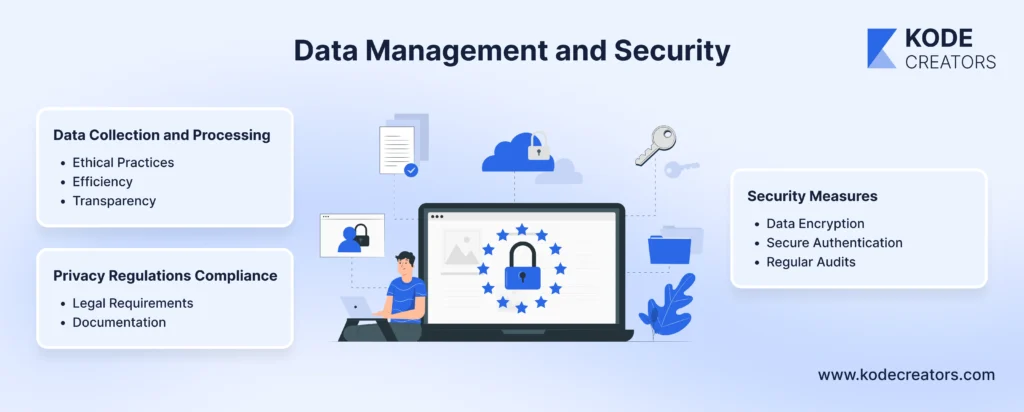
Privacy Regulations Compliance
- Legal Requirements: Adhere to privacy laws like GDPR, CCPA, or other region-specific regulations. This includes obtaining user consent and ensuring data portability.
- Documentation: Maintain detailed records of your data collection and usage practices to demonstrate compliance during audits.
Security Measures
- Data Encryption: Protect sensitive data during storage and transmission with robust encryption protocols.
- Secure Authentication: Implement multi-factor authentication (MFA) to prevent unauthorized access.
- Regular Audits: Conduct routine security audits to identify vulnerabilities and apply timely patches.
Prioritizing ethical data handling, legal compliance, and strong security protocols will protect your users and enhance your product’s reputation in a competitive market.
8. Training and Testing AI Models
The training and testing phase is pivotal in developing an AI SaaS product. A well-trained model ensures your product delivers accurate, reliable results while meeting user expectations.
Data Preparation
- Quality Over Quantity: Use high-quality, relevant datasets. Incomplete or biased data can compromise model performance.
- Preprocessing: Clean and normalize data to remove inconsistencies and prepare it for training.
- Annotation: Label datasets accurately, especially for supervised learning tasks, to improve model precision.
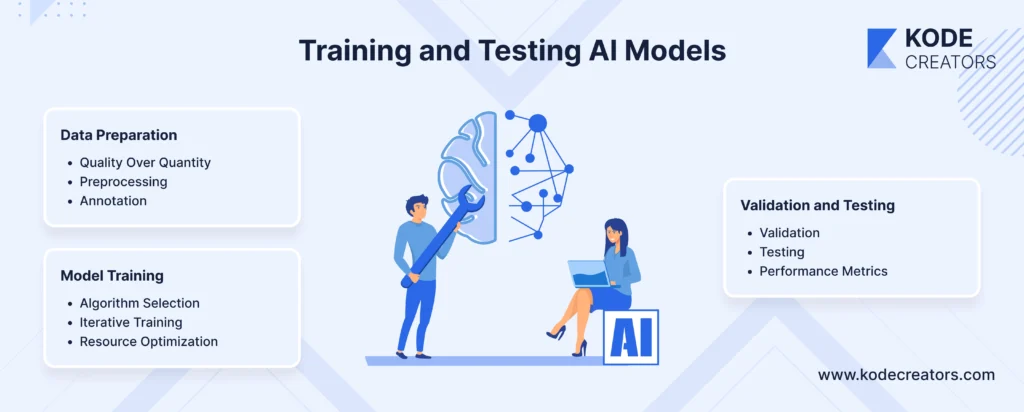
Model Training
- Algorithm Selection: Choose machine learning algorithms or frameworks (e.g., TensorFlow, PyTorch) best suited for your problem.
- Iterative Training: Train the model incrementally, adjusting hyperparameters to improve performance.
- Resource Optimization: Leverage cloud-based services to scale computational power efficiently during training.
Validation and Testing
- Validation: Use a portion of your dataset to validate the model during training, ensuring it generalizes well.
- Testing: Conduct rigorous tests with real-world scenarios to identify weaknesses. Split data into training, validation, and test sets to avoid overfitting.
- Performance Metrics: Evaluate metrics like accuracy, precision, recall, and F1 score to ensure the model meets objectives.
9. Deployment and Scaling
Deployment Strategies
A well-executed deployment strategy ensures a smooth product launch and minimizes potential disruptions. Phased rollouts, such as rolling releases or feature toggles, allow you to introduce the product gradually while mitigating risks. Cloud platforms like AWS, Azure, or Google Cloud provide the flexibility and scalability needed to adapt to varying user demands. Additionally, automating deployment pipelines with CI/CD tools streamlines the process, ensuring consistency, reducing errors, and enabling faster iterations.
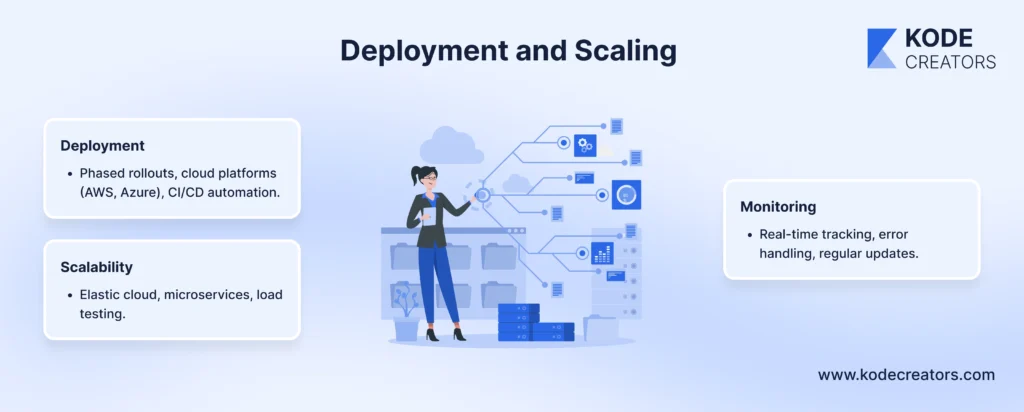
Scalability Planning
Preparing for growth is critical to an AI SaaS product’s long-term success. Elastic cloud infrastructure is a cornerstone of scalability, enabling automatic resource adjustments based on user demand to maintain performance. With a modular architecture and microservices, the application can be scaled independently, optimizing system efficiency. Conducting load testing before deployment helps identify bottlenecks, ensuring the system can handle peak traffic seamlessly.
Monitoring and Maintenance
After deployment, maintaining high performance and reliability is vital. Real-time monitoring tools, such as Datadog or New Relic, track application metrics and flag potential issues early. Implementing robust error tracking systems helps resolve issues quickly, minimizing user impact. Users benefit from regular updates that include bug fixes, feature enhancements, and model improvements, ensuring sustained growth.
10. Cost Estimation
Development Costs
The development phase typically accounts for a significant portion of the budget. Expenses include salaries for the development team, which may consist of AI specialists, software engineers, and project managers. Additional costs cover tools, frameworks, and licenses required for building the product. Testing, which includes unit, integration, and user acceptance tests, also contributes to development costs. Deployment expenses, such as setting up servers or configuring cloud infrastructure, round out this phase.
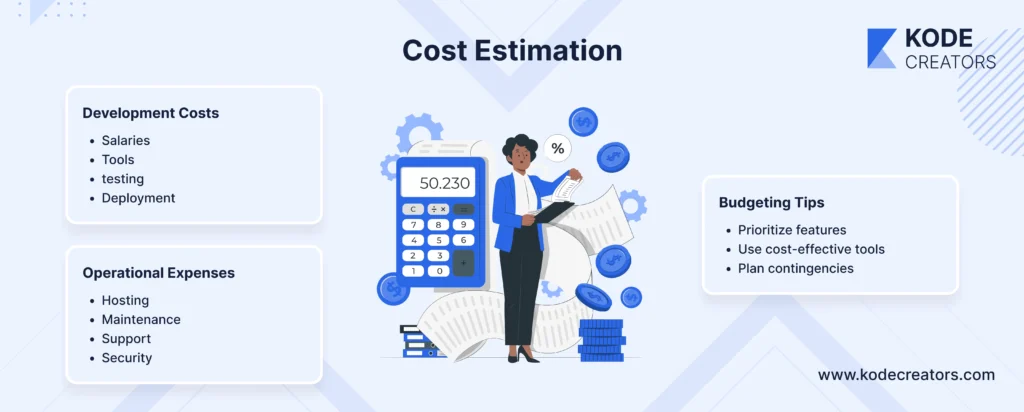
Operational Expenses
Ongoing costs can quickly add up once the product is live. Hosting fees for cloud services like AWS or Azure depend on usage and storage needs, while maintenance ensures the product remains functional and up-to-date. Customer support is another essential expense, as providing timely assistance builds trust and satisfaction among users. Regular updates, security audits, and system monitoring are necessary to keep the product competitive and secure.
Budgeting Tips
Effective budgeting involves forecasting costs and allocating resources strategically. Prioritize essential features in the initial release to control expenses and avoid overextending. Leverage cost-effective tools or open-source solutions where possible. Finally, set aside a contingency fund to cover unforeseen expenses, ensuring your project remains on track even if unexpected challenges arise.
Conclusion:
In conclusion, developing a successful AI SaaS product requires meticulous planning, a robust technological foundation, and a clear understanding of market demands. From identifying the right business problems to deploying and scaling your solution, every step is an opportunity to create value and stand out in a competitive landscape. By aligning your efforts with user needs, prioritizing data security, and budgeting effectively, you set the stage for long-term success. Remember, the journey doesn’t end at launch—continuous monitoring, iteration, and adaptation are key to staying relevant and delivering exceptional experiences to your users.
